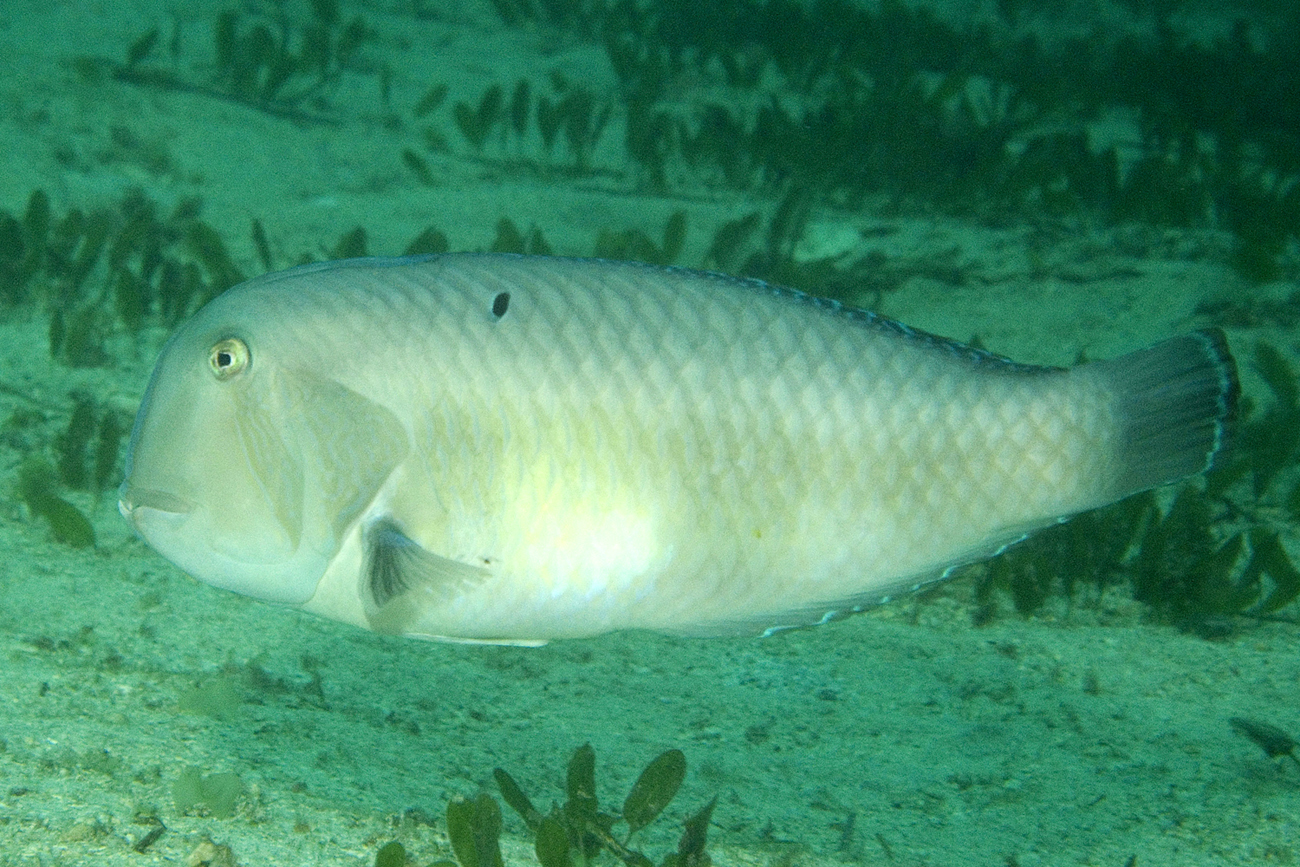Blue Razorfish, Iniistius pavo (Valenciennes 1840)
Other Names: Leaf Wrasse, Pavo Razorfish, Peacock Razorfish, Peacock Wrasse

A Blue Razorfish, Iniistius pavo, at Lord Howe Island, February 21, 2010. Source: Andrew Green / iNaturalist.org. License: CC by Attribution-NonCommercial
Summary:
A razorfish a small dark spot below the anterior part of the dorsal fin, several brown bands on the side, a white patch behind the side behind the pectoral fin, and a diagonal brown bar below the eye.
Juveniles have elongate anterior dorsal-fin spines forming a 'flag" and three ocelli along the dorsal fin. They vary in colour from whitish with dark bars on the body, to overall brown in colour.
Small juveniles mimic drifting leaves and debris.
Species of the genus Iniistius have highly compressed bodies and a steep forehead with a firm knife-like anterior edge - enabling them to easily dive into the sand when threatened.
Juveniles have elongate anterior dorsal-fin spines forming a 'flag" and three ocelli along the dorsal fin. They vary in colour from whitish with dark bars on the body, to overall brown in colour.
Small juveniles mimic drifting leaves and debris.
Species of the genus Iniistius have highly compressed bodies and a steep forehead with a firm knife-like anterior edge - enabling them to easily dive into the sand when threatened.
Cite this page as:
Bray, D.J. 2017, Iniistius pavo in Fishes of Australia, accessed 27 Jun 2025, https://fishesofaustralia.net.au/home/species/296
Blue Razorfish, Iniistius pavo (Valenciennes 1840)
More Info
|
Distribution |
Ningaloo Reef to Rowley Shoals, Western Australia, and Ashmore Reef, Timor Sea, and the Great Barrier Reef, Queensland and reefs in the Coral Sea, with juveniles to Montague Island, New South Wales; also at Christmas Island and Cocos (Keeling) Islands, and Lord Howe Island. Elsewhere the species is widespread in the Indo-west-central Pacific from the Red Sea and East Africa, to the Society Islands, north to southern Japan and Hawaii, south to New Caledonia, Lord Howe Island and New South Wales. Inhabits open sandy areas near reefs. Small juveniles mimic drifting leaf litter and debris. |
|
Species Citation |
Xyrichthys pavo Valenciennes in Cuvier & Valenciennes 1840, Histoire Naturelle des Poissons 14: 61, pl. 394. Type locality: Mauritius. |
|
Author |
Bray, D.J. 2017 |
|
Resources |
Blue Razorfish, Iniistius pavo (Valenciennes 1840)
References
Allen, G.R. & Smith-Vaniz, W.F. 1994. Fishes of the Cocos (Keeling) Islands. Atoll Research Bulletin 412: 21 pp.
Allen, G.R. & Steene, R.C. 1979. The Fishes of Christmas Island, Indian Ocean. Aust. Natl. Parks Wldlf. Ser. Spec. Publ. 2. Canberra : Australian Government Publishing Service 81 pp. 15 pls.
Allen, G.R. & Steene, R.C. 1988. Fishes of Christmas Island Indian Ocean. Christmas Island : Christmas Island Natural History Association 197 pp.
Allen, G.R., Steene, R.C. & Orchard, M. 2007. Fishes of Christmas Island. Christmas Island : Christmas Island Natural History Association 2 edn, 284 pp.
Francis, M.P. 1993. Checklist of the coastal fishes of Lord Howe, Norfolk, and Kermadec Islands, Southwest Pacific Ocean. Pacific Science 47(2):136-170.
Hobbs, J-P.A., Newman, S.J., Mitsopoulos, G.E.A., Travers, M.J., Skepper, C.L., Gilligan, J.J., Allen, G.R., Choat, H.J. & Ayling, A.M. 2014. Checklist and new records of Christmas Island fishes: the influence of isolation, biogeography and habitat availability on species abundance and community composition. Raffles Bulletin of Zoology Supplement 30: 184–202
Kuiter, R.H. 1993. Coastal Fishes of South-eastern Australia. Bathurst : Crawford House Press 437 pp. (image of juvenile misidentified as Iniistius dea)
Kuiter, R.H. 1996. Guide to Sea Fishes of Australia. A comprehensive reference for divers and fishermen. Sydney, NSW, Australia : New Holland Publishers xvii, 434 pp.
Randall, J.E. 2005. Reef and shore fishes of the South Pacific. New Caledonia to Tahiti and the Pitcairn Islands. Honolulu : University of Hawaii Press 707 pp.
Randall, J.E. & Earle, J.L. 2002. Review of the Hawaiian razorfishes of the genus Iniistius (Perciformes: Labridae). Pacific Science 56(4): 389-402.
Russell, B. 2010. Iniistius pavo. The IUCN Red List of Threatened Species 2010: e.T187705A8606763. http://dx.doi.org/10.2305/IUCN.UK.2010-4.RLTS.T187705A8606763.en. Downloaded on 25 January 2017.
Westneat, M.W. 2001. Labridae. pp. 3381-3467 in Carpenter, K.E. & Niem, T.H. (eds) The Living Marine Resources of the Western Central Pacific. FAO Species Identification Guide for Fisheries Purposes. Rome : FAO Vol. 6 pp. 3381-4218.











